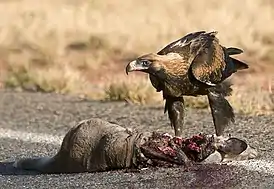Wedge-tailed eagle
The wedge-tailed eagle (Aquila audax) is the largest bird of prey in Australia, and is also found in southern New Guinea. It has long, fairly broad wings, fully feathered legs, and an unmistakable wedge-shaped tail.
| Wedge-tailed eagle | |
|---|---|
 | |
| Scientific classification | |
| Kingdom: | Animalia |
| Phylum: | Chordata |
| Class: | Aves |
| Order: | Accipitriformes |
| Family: | Accipitridae |
| Genus: | Aquila |
| Species: | A. audax |
| Binomial name | |
| Aquila audax (Latham, 1801) | |
| Subspecies[2] | |
| |
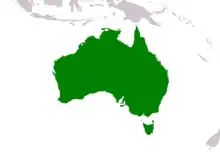 | |
| Range of A. audax Resident | |
The wedge-tailed eagle is one of 12 species of large, predominantly dark-coloured booted eagles in the genus Aquila found worldwide. A large brown bird of prey, it has a wingspan up to 2.84 m (9 ft 4 in) and a length up to 1.06 m (3 ft 6 in).[3]
Taxonomy
The species was first described by the English ornithologist John Latham in 1801 under the binomial name Vultur audax.[4]
The two subspecies are:[5]
- A. a. audax (Latham, 1801) – Australia, southern New Guinea
- A. a. fleayi Condon & Amadon, 1954 – Tasmania
Description
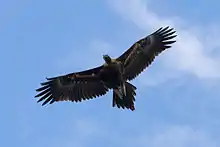

The female wedge-tailed eagle weighs between 3.0 and 5.8 kg (6.6 and 12.8 lb), while the smaller males weigh 2 to 4 kg (4.4 to 8.8 lb).[3][6] Length varies between 81 and 106 cm (32 and 42 in) and the wingspan typically is between 182 and 232 cm (6 ft 0 in and 7 ft 7 in).[3][6] In 1930, the average weight and wingspans of 43 birds were 3.4 kg (7.5 lb) and 204.3 cm (6 ft 8 in).[7] The same average figures for a survey of 126 eagles in 1932 were 3.63 kg (8.0 lb) and 226 cm (7 ft 5 in), respectively.[8] The largest wingspan ever verified for an eagle was for this species. A female killed in Tasmania in 1931 had a wingspan of 284 cm (9 ft 4 in), and another female measured barely smaller at 279 cm (9 ft 2 in).[8] Similar claims, however, have been made for the Steller's sea eagle, which has also been said to reach or exceed 274 cm (9 ft) in wingspan. Reported claims of eagles spanning 312 cm (10 ft 3 in) and 340 cm (11 ft 2 in) were deemed to be unreliable.[8] This eagle's great length and wingspan place it among the largest eagles in the world, but its wings, at more than 65 cm (26 in), and tail, at 45 cm (18 in), are both unusually elongated for its body weight, and eight or nine other eagle species regularly outweigh it.[6]
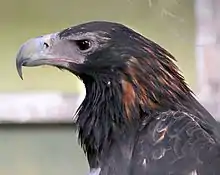
Young eagles are a mid-brown colour with slightly lighter and reddish-brown wings and head. As they grow older, their colour becomes darker, reaching a dark blackish-brown shade after about 10 years (birds in Tasmania are usually darker than those on the mainland). Adult females tend to be slightly paler than males. Although it rarely needs to be distinguished from other Aquila eagles, its long, wedge-shaped tail is unique to this species.
Its range and habitat sometimes overlap with the white-bellied sea eagle, which is similar in size and shape, and also has a somewhat wedge-shaped tail, although rather smaller and less distinctive. In silhouette and poor light, the two can look somewhat similar. Closer examination reveals the belly colour or tail size to distinguish the two.
Breeding and habitat

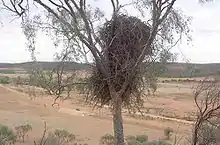
Wedge-tailed eagles are found throughout Australia, including Tasmania, and southern New Guinea in almost all habitats, though they tend to be more common in lightly timbered and open country in southern and eastern Australia. They are widespread throughout the desert interior of Australia, however are rare or occur at low densities in the most arid parts of the continent, such as the Lake Eyre Basin. In New Guinea, the birds can be found in the Trans-Fly savanna and grasslands.
As the breeding season approaches, wedge-tailed eagle pairs perch close to each other and preen one another. They also perform dramatic aerobatic display flights together over their territory. Sometimes, the male dives down at breakneck speed towards his partner. As he pulls out of his dive and rises just above her; she either ignores him or turns over to fly upside down, stretching out her talons. The pair may then perform a loop-the-loop. The wedge-tailed eagle usually nests in the fork of a tree between one and 30 m above the ground, but if no suitable sites are available, it will nest on a cliff edge.
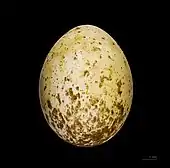
_(15240110168).jpg.webp)
Before the female lays eggs, both birds either build the large stick nest or add new sticks and leaf lining to an old nest. Nests can be 2–5 m deep and 2–5 m wide. The female usually lays two eggs, which are incubated by both sexes. After about 45 days, the chicks hatch. At first, the male does all the hunting. When the chicks are about 30 days old, the female stops brooding them and joins her mate to hunt for food.
The young wedge-tailed eagles depend on their parents for food up to six months after hatching. They leave only when the next breeding season approaches.
Behaviour and diet
Wedge-tailed eagles are highly aerial, soaring for hours on end without wingbeat and seemingly without effort, regularly reaching 1,800 m (5,900 ft) and sometimes considerably higher. The purpose of soaring is unknown. Their keen eyesight extends into ultraviolet bands.
.jpg.webp)
Most prey is captured on the ground in gliding attacks or (less frequently) in the air. Choice of prey is very much a matter of convenience and opportunity; since the arrival of Europeans, the introduced rabbit and brown hare have become the primary items of the eagle's diet in many areas.[9] Larger introduced mammals such as foxes and feral cats are also occasionally taken, while native animals such as wallabies, small kangaroos, possums, wombats, koalas, and bandicoots are also prey. In some areas, birds such as cockatoos, Australian brushturkeys, ducks, crows, ibises, and even young emus are more frequent prey items. Reptiles are less frequently taken, but can include frill-necked lizards, goannas, bearded dragons, and brown snakes.
They display considerable adaptability, and have been known to team up to hunt large red kangaroos, to cause goats to fall off steep hillsides and injure themselves, or to drive flocks of sheep or kangaroos to isolate a weaker animal.[10]
Carrion is a major diet item, also; wedge-tails can spot the activity of Australian ravens around a carcass from a great distance, and glide down to appropriate it. Wedge-tailed eagles are often seen by the roadside in rural Australia, feeding on animals that have been killed in collisions with vehicles.
This impressive bird of prey spends much of the day perching in trees or on rocks or similar exposed lookout sites such as cliffs from which it has a good view of its surroundings. Now and then, it takes off from its perch to fly low over its territory. During the intense heat of the middle part of the day, it often soars high in the air, circling up on the thermal currents that rise from the ground below. Each pair occupies a home range, which may extend from as little as 9 km2 (3.5 sq mi) to more than 100 km2 (39 sq mi). Within this home range lies a breeding territory around the nest. The eagle patrols the boundary of this home range and advertises its ownership with high-altitude soaring and gliding flights. It may defend its territory by diving on intruders. Adults are avian apex predators and have no natural predators, but must defend their eggs and nestlings against nest predators such as corvids, currawongs, or other wedge-tailed eagles, and in Tasmania, conflict with the white-bellied sea eagle often occurs over nest sites.
The wedge-tailed eagle is the only bird that has a reputation for attacking hang gliders and paragliders (presumably defending its territory). Cases are recorded of the birds damaging the fabric of these gliders with their talons. They have also been reported to attack and destroy unmanned aerial vehicles used for mining survey operations in Australia.[11]
The presence of a wedge-tailed eagle often causes panic among smaller birds, and as a result, aggressive species such as magpies, butcherbirds, masked lapwings, and noisy miners aggressively mob eagles (see video).
Conservation status
The subspecies from Tasmania (A. a. fleayi) is listed as endangered by the Environment Protection and Biodiversity Conservation Act 1999[12] with fewer than 200 pairs left in the wild. Like the thylacine, the eagle was once subject to a bounty in Tasmania, as it was believed to prey on livestock.
Decreased numbers of Tasmanian devils (which are endangered) may be beneficial to the wedge-tailed eagles in Tasmania, as it could reduce competition for roadkill and devil predation on wedge-tailed eagle young, although that is not to say that devil populations should be reduced further.[13]
As an emblem
The bird is an emblem of the Northern Territory. The Parks and Wildlife Service of the Northern Territory uses the wedge-tailed eagle, superimposed over a map of the Northern Territory, as their emblem. The New South Wales Police Force emblem contains a wedge-tailed eagle in flight, as does the Northern Territory Correctional Services. La Trobe University in Melbourne also uses the wedge-tailed eagle in its corporate logo and coat of arms.[14] The wedge-tailed eagle is also a symbol of the Australian Defence Force, featuring prominently on the ADF Flag, and the Royal Australian Air Force and Australian Air Force Cadets both use a wedge-tailed eagle on their badges.[15] The Royal Australian Air Force has named its airborne early warning and control aircraft after the bird, the Boeing E-7 Wedgetail.
Early in 1967, the Australian Army 2nd Cavalry Regiment received its new badge, a wedge-tailed eagle swooping, carrying a lance-bearing the motto "Courage" in its talons. The regiment's mascot is a wedge-tailed eagle named "Courage". Since its formation, there have been two, Courage I and Courage II. In 1997, while on flight training with his handlers, Corporal Courage II refused to cooperate and flew away, not being found for two days following an extensive search. He was charged with being AWOL and reduced to the rank of trooper. He was promoted back to corporal in 1998.[16][17]
The West Coast Eagles AFL football club from Western Australia uses a stylised wedge-tailed eagle as their club emblem. In recent years, they have had a real-life wedge-tailed eagle named "Auzzie" perform tricks before matches.[18]
References
- BirdLife International (2012). "Aquila audax". IUCN Red List of Threatened Species. 2012. Retrieved 26 November 2013.
- Gill F, D Donsker & P Rasmussen (Eds). 2020. IOC World Bird List (v10.2). doi : 10.14344/IOC.ML.10.2.
- Debus, S.J.S. (1994). "Wedge-tailed Eagle (Aquila audax)". In del Hoyo, Elliott; Sargatal (eds.). Handbook of the Birds of the World. 2. p. 198. ISBN 84-87334-15-6.
- Latham, John (1801). Supplementum indicis ornithologici sive systematis ornithologiae (in Latin). London: Leigh & Sotheby. p. ii.
- Gill, Frank; Donsker, David (eds.). "New World vultures, Secretarybird, kites, hawks & eagles". World Bird List Version 5.4. International Ornithologists' Union. Retrieved 24 January 2016.
- Ferguson-Lees, Christie; Franklin, Mead & Burton (2001). Raptors of the World. Houghton Mifflin. ISBN 0-618-12762-3.
- Morgan, A. M. (1932). "The Spread and Weight of the Wedge-tailed Eagle (Uroaetus audax)" (PDF). S.A. Ornithologist. 11: 156–7.
- Wood, Gerald (1983). The Guinness Book of Animal Facts and Feats. ISBN 978-0-85112-235-9.
- Brooker, M.G.; Ridpath, M.G. (1980). "The Diet of the Wedge-tailed Eagle, Aquila Audax, in Western Australia". Australian Wildlife Research. 7 (3): 433–452. doi:10.1071/WR9800433.
- Beattie, William A. (1990). Beef Cattle Breeding & Management. Popular Books. ISBN 0-7301-0040-5.
- "Wedge-tailed eagles do battle with mining giant's drones, knocking nine out of sky". The Sydney Morning Herald. 17 November 2016.
- Department of the Environment. "Aquila audax fleayi — Wedge-tailed Eagle (Tasmanian)". Australian Government. Retrieved 25 January 2009.
- "DRAFT Recovery Plan for the Tasmanian devil (Sarcophilus harrisii)" (PDF). Department of Primary Industries, Parks, Water and Environment, Australian Government. 2010. p. 15. Archived from the original (PDF) on 4 March 2011.
- "Our history". La Trobe.
- Force, Air (3 December 2019). "Royal Australian Air Force - Air Force provides air and space power for Australia's security".
- "2 Cav. 2nd Cavalry Regiment RAAC".
- 2nd Cavalry Regiment (Australia)
- "Auzzie Flies High With The West Coast Eagles".
Further reading
- Burridge CP, Brown WE, Wadley J, Nankervis DL, Olivier L, Gardner MG, Hull C, Barbour R, Austin JJ (2013). "Did postglacial sea-level changes initiate the evolutionary divergence of a Tasmanian endemic raptor from its mainland relative?". Proc. Biol. Sci. 280 (1773): 20132448. doi:10.1098/rspb.2013.2448. PMC 3826236. PMID 24174114.
External links
| Wikimedia Commons has media related to Aquila audax. |
| Wikispecies has information related to Aquila audax. |
- "Aquila audax audax". NCBI Taxonomy Browser. 433367.
- "Aquila audax fleayi". NCBI Taxonomy Browser. 433368.

